Rating of the best drops for conjunctivitis for 2024
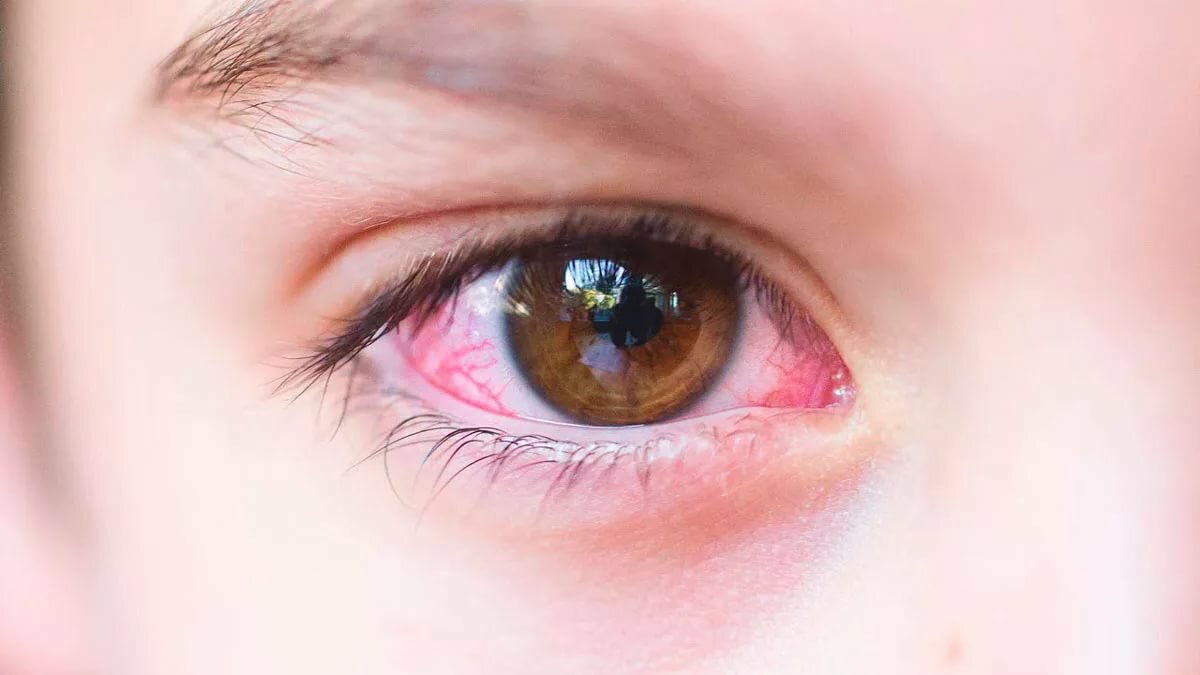
Irritated itchy "red" eyes full of tears are a vivid picture of developing conjunctivitis. Not everyone knows that often passing by itself, it can in some cases cause serious ophthalmic disease. Therefore, in the event of the appearance of such symptoms, it is necessary, first of all, to consult a specialist, and then begin the appropriate treatment.
Types of conjunctivitis
Conjunctivitis is an inflammatory lesion of the conjunctiva, which is manifested by overflow of blood vessels (hyperemia) and edema of the mucous membranes of the eye, edema and itching of the eyelids, the appearance of a pathological mucous or purulent discharge.
Inflammation of the conjunctiva is a fairly common disease, about 40% of all ophthalmic diseases are lesions of the mucous membrane of the eye. This prevalence is facilitated by a large number of causes that contribute to the development of this inflammation. The main ones are:
- bacteria - staphylococci, streptococci, pneumococci, etc.
In the case of bactericidal infection, it manifests itself as an independent disease.
- viruses - adenoviruses (most often), smallpox, measles, herpes.
With a viral infection of the body, conjunctivitis is a secondary manifestation of the infection.
- fungi.
It appears most often in the case of a general weakening of the immune system and is quite rare.
- chlamydia - microbes.
Chlamydial conjunctivitis affects people who have been diagnosed with chlamydia of the genitourinary tract, and its development is possible in newborns as a result of infection during childbirth from a sick mother. It is not uncommon for the chlamydial species to develop after visiting public baths or swimming pools.
- non-infectious factors - dust, smoke, various chemicals, pollen and other allergens.
These factors most often cause allergic conjunctivitis, which is most often seasonal.
In addition to the above-mentioned main causes, inflammation of the mucous membrane of the eye can occur against the background of a strong weakening of the immune system (for example, with tuberculosis, HIV), various pathologies of vision, mechanical trauma of the eye, poor hygiene when wearing contact lenses, dry eye syndrome, etc.
Based on the causes of inflammation, there are 5 main types of disease:
- bacterial - more common in children;
- viral - as a secondary manifestation of infections caused by viruses;
- allergic - seasonal;
- chlamydial - "bath";
- fungal.
Regardless of the origin, the disease has manifestations characteristic of all its types. Most often these are:
- swelling;
- increased filling of blood vessels of the mucous membrane of the eye;
- itching and burning;
- sensation of a foreign body in the eye;
- increased lacrimation;
- increased sensitivity to light.
In addition to common symptoms, each type of conjunctivitis has specific manifestations, which are more specifically described in the table below.
| Conjunctivitis type | Specific manifestations |
|---|---|
| Bacterial | Sharply appearing hyperemia of the mucous membrane, edema of the eyelid, sensation of "sand" in the eyes, mucopurulent discharge, after sleep - stuck eyelashes, severe itching and burning in the eye area. One eye is most often affected, but over time, symptoms appear in the other. A high level of infectiousness is characteristic. It is transmitted through household items - towels, bed linen, etc. |
| Viral | Herpetic conjunctivitis: photophobia, profuse lacrimation, blepharospasm (involuntary closing of the eyelids), the appearance of watery blisters on the eyelids, as well as their redness and swelling. Adenoviral conjunctivitis: mucous discharge, burning, stinging, feeling of "sand" in the eyes, redness of the conjunctiva and eyelids, increased photosensitivity, lacrimation. Both eyes are affected at once. It is transmitted through contact with the patient, through hands, household items, etc. |
| Allergic | Severe itching and burning under the eyelids, increased lacrimation and photosensitivity, mucous discharge, blepharospasm may develop. Both eyes are affected at the same time. Not contagious. |
| Fungal | Symptoms can vary depending on the type of athlete's foot causing the inflammation. |
| Chlamydial | Severe swelling of the eyelids and mucous membranes of the eye, profuse discharge of mucus and pus from the conjunctival sac, enlargement of the lymph node near the auricle. It is highly contagious and spreads quickly through household contact. |
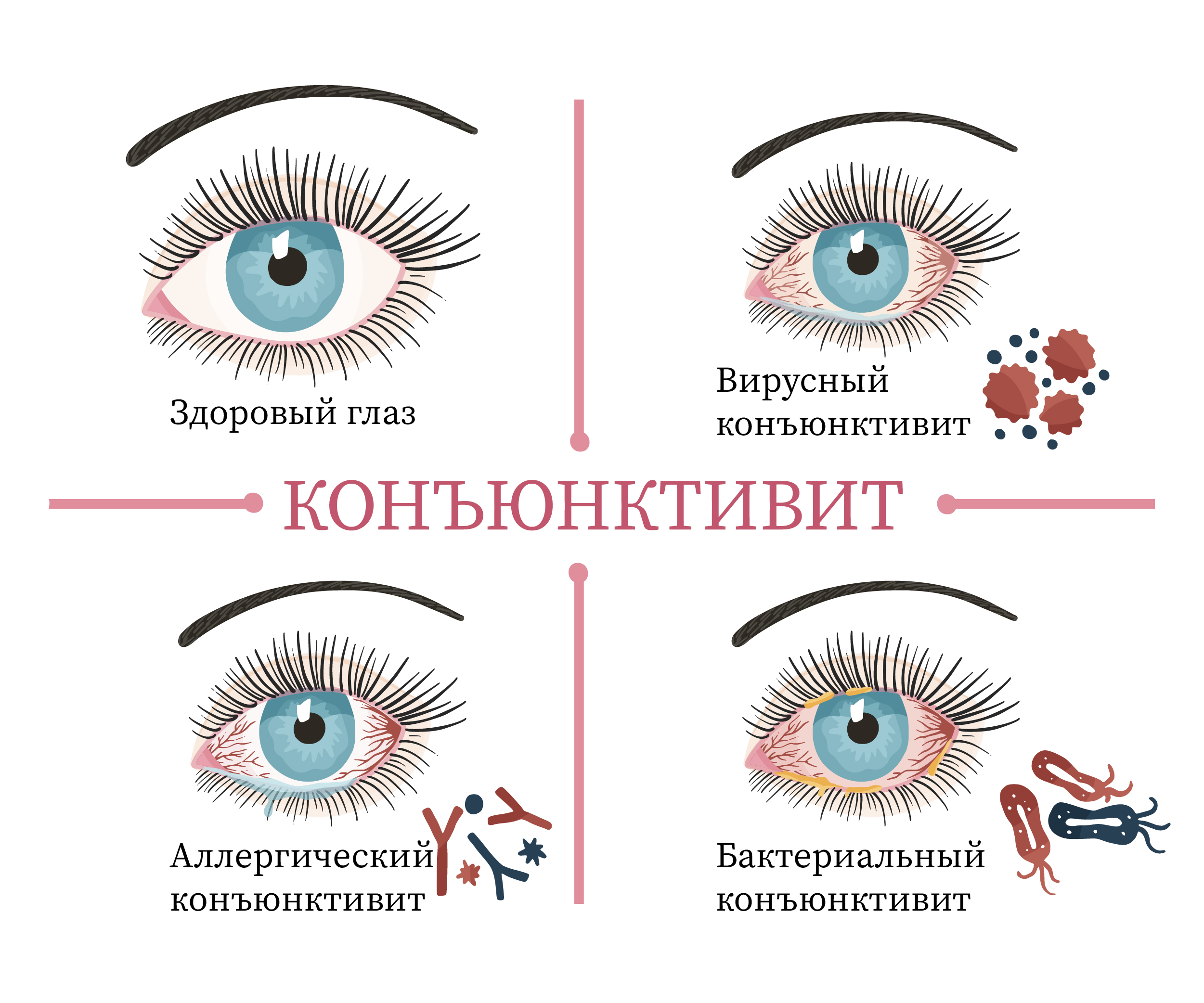
Treatment of all types of the disease is based on eliminating the causes of the inflammatory process, as well as removing unpleasant symptoms. For this, medications are used in the form of solutions injected into the eyes.
The best remedies for conjunctivitis
Below we will consider the best eye solutions for viral, bacterial and allergic inflammation of the mucous membrane of the eyes for adults, children, and also pregnant women.
Antiviral drugs for adults
Aktipol
The active component of Aktipol is para-aminobenzoic acid, which has antiviral, immunomodulatory and antioxidant effects. To combat adenoviral and herpetic conjunctivitis, 1-2 drops are prescribed up to 8 times a day with a gradual decrease in the frequency of use. To enhance the effect, it can be prescribed in combination with antibiotics and modified nucleosides (for example, acyclovir). Actipol can be purchased with a doctor's prescription.
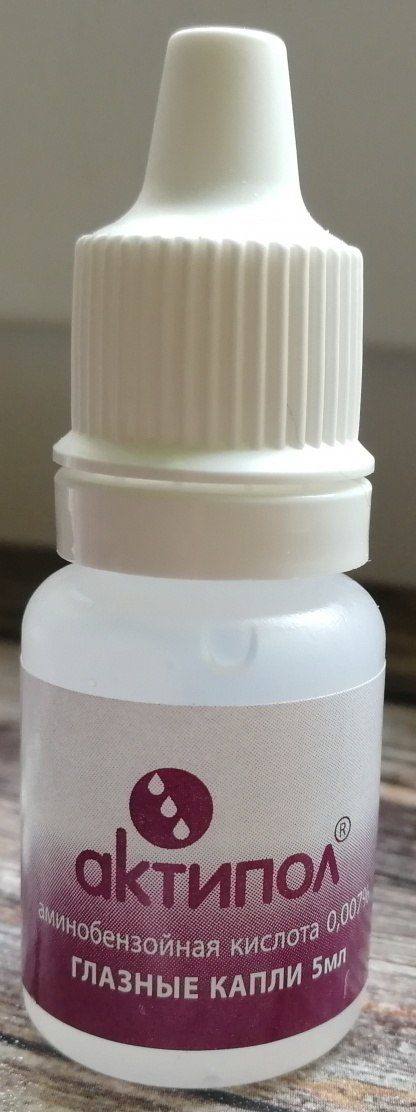
Cost of 5 ml: from 350 rubles.
- can be prescribed to pregnant women;
- helps with dry eye syndrome;
- used for burns and other eye injuries;
- does not cause discomfort when instilled;
- can be used while wearing lenses;
- quickly and effectively copes with unpleasant symptoms of the disease;
- convenient packaging - a plastic bottle with a dropper cap.
- small volume of the bottle;
- expensive.
Ophthalmoferon
Antiviral agent, the main active ingredients of which are interferon alpha-2b and diphenhydramine. Thanks to this composition, Oftalmoferon has a complex effect: antiviral, immunomodulatory and antiallergic. It is prescribed for adenovirus, herpetic and enteroviral conjunctivitis. The dosage is 1-2 drops up to 8 times a day in the acute stage and decreases to 3 times a day as the symptoms subside. Sold without a prescription.
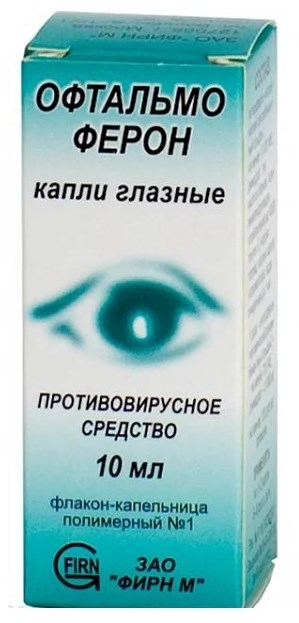
Cost of 10 ml: from 290 rubles.
- use in pregnant women and children is allowed;
- the use of the drug does not exclude the possibility of wearing contact lenses;
- quickly relieves unpleasant symptoms;
- combined with other antibacterial and anti-inflammatory drugs;
- effective for dry eye syndrome;
- convenient dropper bottle that does not require the purchase of a pipette.
- inconvenient storage conditions (from 2 to 8aboutC), which are difficult to observe when there is no refrigerator nearby.
Antibacterial eye drops for adults
Sofradex
These Sofradex contain antibiotics framycetin sulfate and gramicidin in combination with the glucocorticosteroid dexamethasone (a hormone), which are responsible for the antibacterial properties of the drug. It has been proven effective against gram-positive and gram-negative microorganisms, streptococci, staphylococci, etc. The course is 7 days, during which the recommended dosage is 1-2 drops 6 or more times a day. Suitable for the treatment of children from 7 years of age. Sold by prescription.
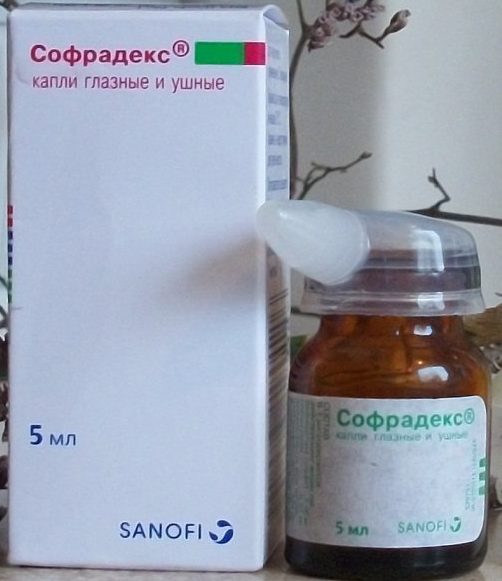
Cost of 5 ml: from 290 rubles.
- stored at room temperature;
- after a day of application, a positive result is visible;
- copes even in advanced cases.
- burn a little when instilled;
- can not be used during pregnancy and lactation;
- cannot be used to treat viral diseases and red eye syndrome;
- not very convenient dosing cap.
Ciprofloxacin
Broad-spectrum antibacterial solution based on hydrochloride monohydrate. Effective against enterobacteriaceae, aerobic, gram-negative, gram-positive and intracellular (chlamydia) pathogens. It is prescribed for the acute form of bacterial conjunctivitis. It is applied 1-2 drops every 2 hours at the onset of the disease, gradually the dosage is reduced to 1-2 drops every 4 hours. Ciprofloxacin is well tolerated by most patients; in rare cases, an allergic reaction is possible in the form of burning and reddening of the sclera, slight swelling of the eyelids. The solution can be used to treat inflammation of the conjunctiva in children over 1 year old. Available without a prescription.
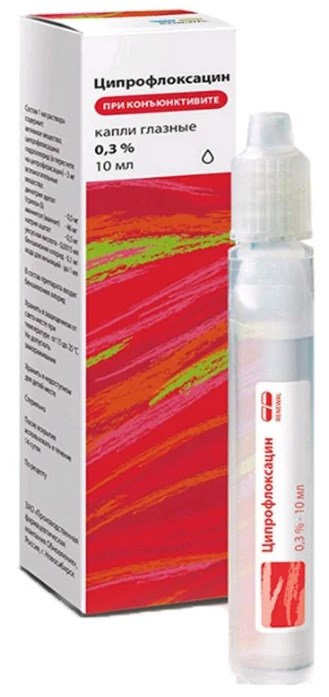
The cost of a 10 ml bottle: from 38 rubles.
- suitable for children over 1 year old;
- does not sting;
- convenient packaging - a dropper bottle made of soft transparent plastic;
- after 1 day of use, a noticeable result is observed;
- convenient storage conditions (from 15 to 25aboutFROM);
- low cost.
- not suitable for pregnant women;
- the instillation of the solution should not be combined with the wearing of contact lenses.
Levomycetin
The active substance chloramphenicol is a bacteriostatic antibiotic that copes well with most infectious ophthalmic diseases caused by pathogenic microorganisms. The course is no more than 5 days. Dosage - 1-2 drops up to 4 times a day.
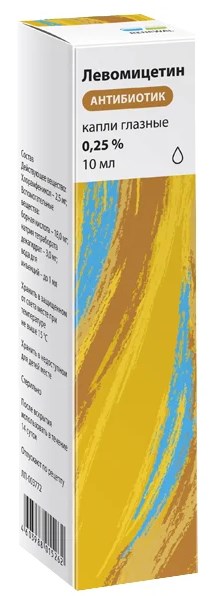
Cost of 10 ml: from 77 rubles.
- wide antimicrobial spectrum of action;
- does not burn;
- it is possible to appoint children over 1 month old;
- stored at room temperature;
- convenient dropper bottle;
- cheap.
- not used to treat eye infections in pregnant and lactating women;
- the use of the solution cannot be combined with the wearing of contact lenses;
- can not be used for dry eye syndrome;
Tsipromed
The active ingredient in this antibacterial drug is ciprofloxacin. It is effective in the fight against the following microorganisms: streptococci, staphylococci, gonococci, chlamydia, E. coli and Pseudomonas aeruginosa, salmonella, etc. The dosage depends on the severity of the disease and can vary from 4 to 8 times a day, 1 drop.
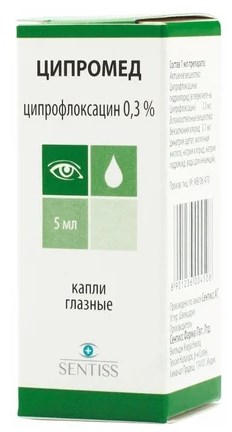
Cost of 5 ml: from 120 rubles.
- can be used to treat children over 1 year old;
- room temperature is enough for storage;
- convenient packaging does not require the purchase of a pipette.
- not prescribed for pregnant and lactating women;
- incompatible with wearing contact lenses;
- instillation may be accompanied by a burning sensation and cause an allergic reaction in the form of puffiness of the eyelids, tearing, photophobia.
Okomistin
The main component of Okomistin is Miramistin, an antiseptic with a bright antimicrobial effect. It is effective against gram-positive, gram-negative, aerobic and anaerobic bacteria.Also, in combination with antibiotics, it helps to fight chlamydia, pathogenic fungi, adenovirus, herpes virus. The dosage is 1-2 drops up to 6 times a day. It is used to treat children from 3 years old.
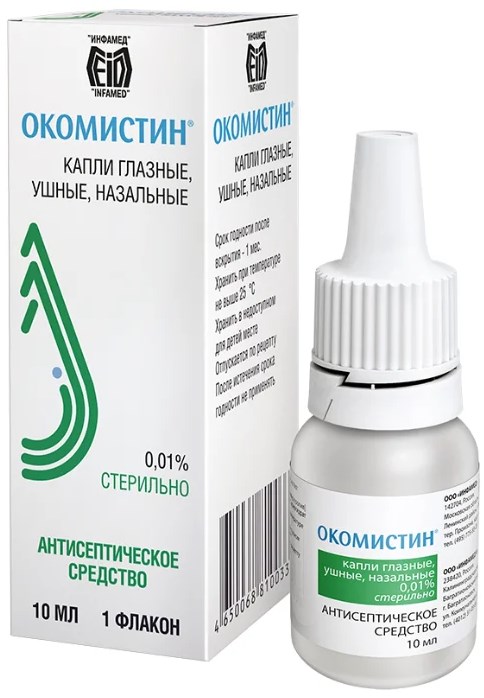
Cost of 10 ml: from 170 rubles.
- suitable for children over 3 years old;
- is used to treat ophthalmic diseases in pregnant and lactating women;
- can be combined with wearing contact lenses (put on 15 minutes after instillation);
- the plastic bottle is equipped with a dropper cap;
- stored at room temperature;
- no discomfort when instilled in the eyes.
- not found.
Remedies for allergic conjunctivitis in adults
Opatanol
The active ingredient in this drug is olopatadin, which is a selective blocker of histamine H1 receptors. It is characterized by a pronounced anti-allergic effect. The dosage is the same for adults and children over 3 years old - 1 drop 2 times a day. Sold by prescription.
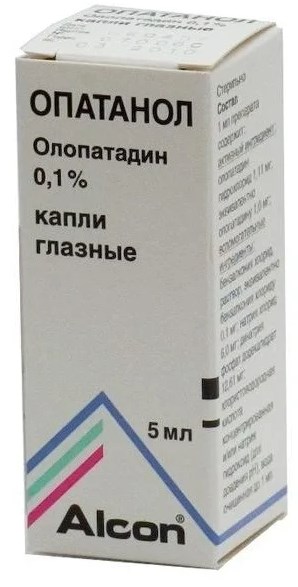
Cost of 5 ml: from 496 rubles.
- not addictive - long-term use is possible up to 4 months;
- do not pinch;
- quickly relieve unpleasant symptoms of allergic inflammation of the eye mucosa;
- convenient dropper bottle;
- can be used by pregnant women on the recommendation of a doctor;
- storage at room temperature.
- expensive.
Allergodil
Antiallergic drug based on azelastine hydrochloride - a blocker of histamine H1-receptors. Allergodil is used for the prevention and treatment of both seasonal and year-round allergic conjunctivitis. Dosage - 1 drop 2 to 4 times a day. The use of Allergodil is possible in children over 4 years old. Dispensed without a doctor's prescription.
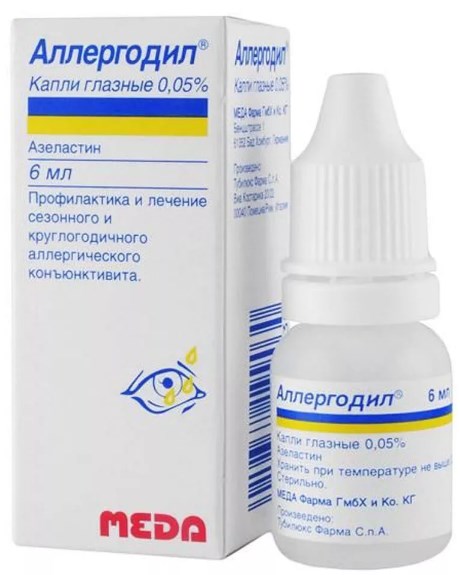
The cost of 6 ml: from 480 rubles.
- has a prolonged effect;
- long-term effect;
- used by pregnant women in the 2nd and 3rd trimester;
- used for treatment in childhood;
- quickly removes allergy symptoms;
- no addiction.
- you can not wear contact lenses while instilling the product;
- can not be used during 1 trimester of pregnancy and during breastfeeding;
- slight burning and redness of the mucous membrane of the eye immediately after instillation;
- dry eyes in some;
- expensive.
Okumetil
Okumetil contains 3 active ingredients: zinc sulfate, naphazoline hydrochloride and diphenhydramine hydrochloride. This combination of active substances provides simultaneously astringent, anti-inflammatory, antiseptic, vasoconstrictor and anti-allergic action. To obtain a positive result, it is enough to bury the eyes for 3 days, 1 drop 3 times a day. Sold without a prescription.
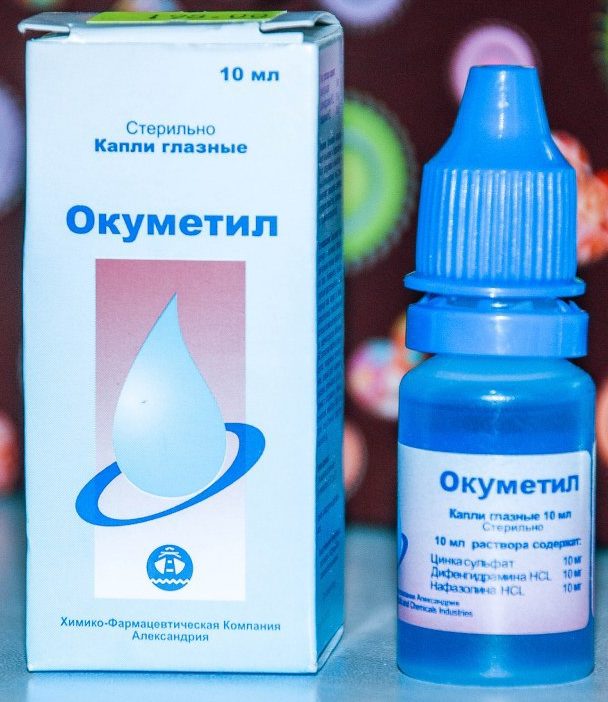
Cost of 10 ml: from 275 rubles.
- quickly relieves eye redness and itching;
- can be used in the treatment of children over 2 years old;
- stored at room temperature.
- a large number of contraindications;
- not used to treat pregnant or lactating women;
- causes dry eyes;
- temporary decrease in vision immediately after instillation;
- dilates the pupils (can dilate in different ways);
- the solution has a blue color, after it gets on things, the latter are not washed off.
Antibacterial drugs for children
Babies are most likely to experience bacterial conjunctivitis. Consider the most effective medicine in the form of drops to combat this type of disease.
Vitabact
Antimicrobial drug, the main active ingredient of which is picloxidine diichloride. It is active against most pathogens of bacterial infections affecting the anterior part of the eyes. The course is 10 days, during which you should instill 1 drop from 2 to 6 times a day. Vitabact is sold in a sealed polyethylene bottle with a dropper. It is prescribed for the treatment of children from birth. Sold without a prescription.
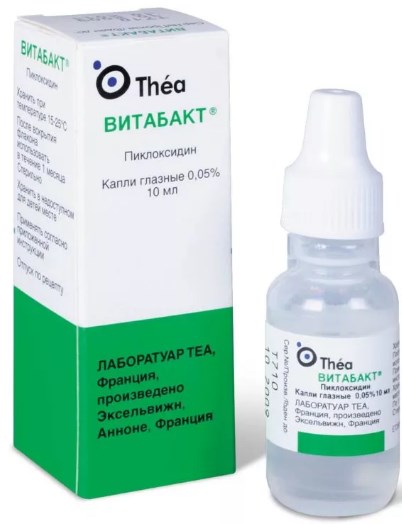
Cost of 10 ml: from 368 rubles.
- suitable for children from birth;
- a wide spectrum of action - copes not only with bacteria, but also with some types of viruses and fungi;
- are not an antibiotic;
- cope with the manifestations of bacterial inflammation within a few days;
- stored at room temperature.
- in some cases, may cause temporary redness of the eyes;
- not suitable for pregnant and lactating women;
- more expensive than similar products.
Tobrex
The active ingredient in the drug is tobramycin, which is a broad-spectrum antibiotic. It is active against most gram-negative and some gram-positive bacteria. At the same time, it does little to help with inflammation caused by group D streptococci. The dosage is selected individually depending on the course of the disease, on average it is 1 drop 4-5 times a day. This dosage is prescribed for both adults and children from 1 year old. Can be used to treat newborns. Sold without a prescription.
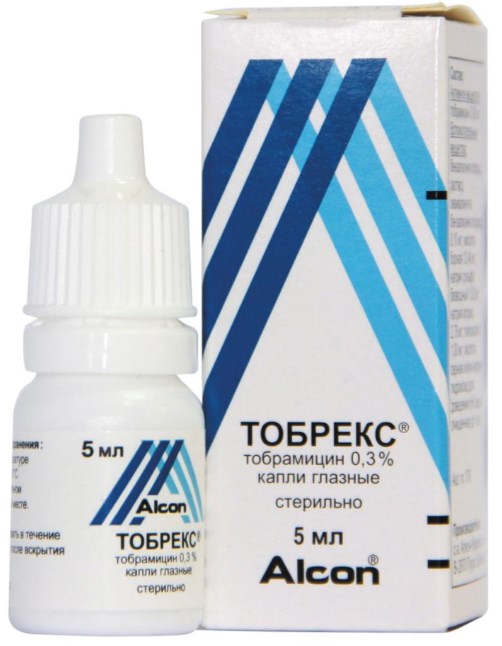
Cost of 5 ml: from 183 rubles.
- it is prescribed for children over 1 year old, but can be used under the guidance of a doctor and for newborns;
- no burning sensation when instilled;
- stored at a temperature of 17-27aboutFROM;
- convenient bottle with a drip system;
- not used in the treatment of pregnant women in the 1st and 2nd trimester and during breastfeeding.
Sulfacil sodium
Sulfacetamide-based antibacterial agent. Shows activity against most gram-positive and gram-negative bacteria, as well as chlamydia, intestinal and Pseudomonas aeruginosa. Produced in different concentrations: 10% for newborns and infants, 20 and 30% - over 6 years old and adults, respectively. The dosage is 2-3 drops 3 times a day.
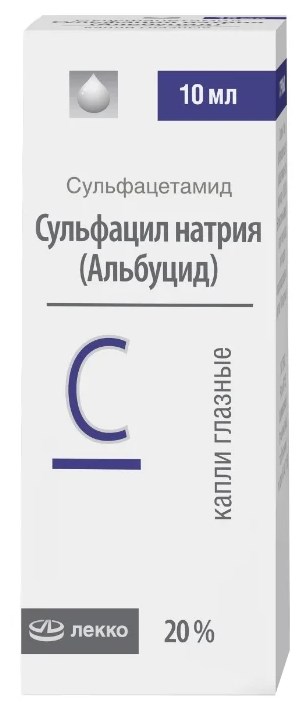
Cost of 10 ml: from 42 rubles.
- a wide range of actions;
- quickly and effectively cope with eye inflammation caused by bacteria;
- used for children from birth;
- effective in the treatment of rhinitis with green secretions;
- low cost.
- stinging eyes;
- an unpleasant taste in the mouth after instillation.
Drugs for allergic conjunctivitis in children
Spersallerg
Antiallergic agent based on antazoline hydrochloride and tetrizoline hydrochloride. This composition of the drug allows it to work in two directions: on the one hand, it blocks the H1-histamine receptors and relieves itching, on the other, it narrows the vessels, thereby relieving hyperemia and edema of the conjunctiva. The dosage depends on age: 1 drop once a day for children, 2-3 times a day for adults. It is used for treatment from 2 years. It is released in pharmacies freely.

Cost of 10 ml: from 1640 rubles.
- speed - the effect is observed within 15 minutes after application;
- long-term effect;
- suitable for emergency treatment during allergies.
- can cause a number of side effects: burning, dryness, decreased visual acuity;
- can not be used for more than 2 weeks;
- not suitable for pregnant women and during lactation;
- expensive.
Also, to relieve unpleasant symptoms caused by allergies, in children, Allergodil (from 4 years old) and Okumetil (from 2 years old) described in preparations for adults can be used. With viral inflammation of the conjunctiva, children can be prescribed Aktipol, but only after consulting a specialist.
Preparations for pregnant women
Pregnant women should be especially careful when choosing medicines, because many of them are allowed for use only conditionally. Of those considered above, the most safe for women in position are the following:
- with viral eye inflammation - Aktipol, Oftalmoferon;
- with bacterial - Okomistin, Sulfacil sodium (Albucid), Tobrex (only 3 trimester):
- for allergic - Allergodil (starting from the 2nd trimester of pregnancy), Opatanol.
Conjunctivitis is a very unpleasant disease, but it is quite curable. It is important not to experiment on yourself and not to self-medicate. When the first unpleasant symptoms appear, it is important to consult an ophthalmologist to determine the type of inflammation and its source.It is worth using drugs only according to the instructions, even those that are sold without a prescription. To prevent the appearance of the disease, do not neglect hygienic measures, wash your hands more often, touch your eyes less with your hands, especially on the street and in public places, do not use other people's cosmetics for make-up and your look will always be clean and clear.
new entries
Categories
Useful
Popular articles
-

Top rating of the best and inexpensive scooters up to 50 cubic meters in 2024
Views: 97661 -

Rating of the best materials for noise insulation for an apartment in 2024
Views: 95022 -

Rating of cheap analogues of expensive medicines for flu and colds for 2024
Views: 91751 -

The best men's running shoes in 2024
Views: 87681 -

Top ranking of the best smartwatches 2024 - price-quality
Views: 85091 -

Best Complex Vitamins in 2024
Views: 84801 -

The best dye for gray hair - 2024 top ranking
Views: 82406 -

Rating of the best wood paints for interior use in 2024
Views: 77202 -

Ranking of the best action cameras from China in 2024
Views: 75269 -

Rating of the best spinning reels in 2024
Views: 74827 -

The most effective calcium supplements for adults and children in 2024
Views: 72462 -

Top rating of the best in 2024 means for male potency with a description
Views: 68296









